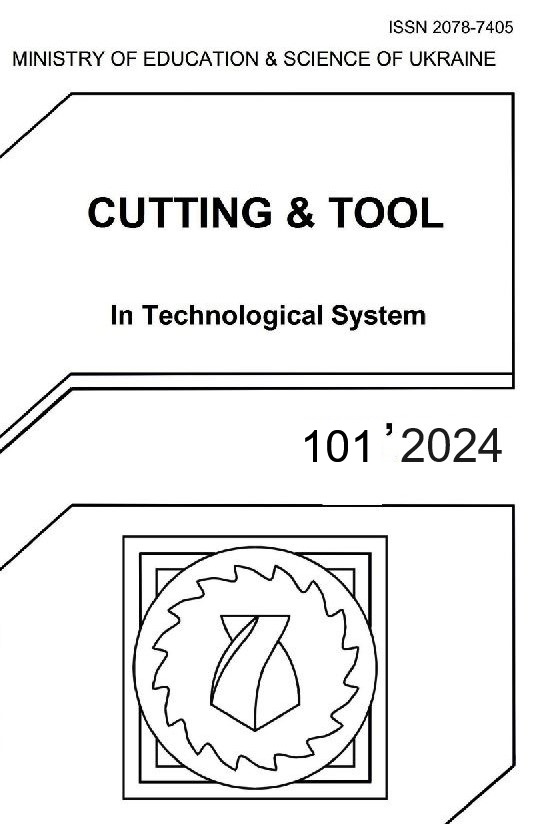INFLUENCE OF DIAMOND BURNISHING ON CORE HEIGHT AN TEN-POINT HEIGHT
DOI:
https://doi.org/10.20998/2078-7405.2024.101.03Keywords:
3D roughness parameters, diamond burnishing, surface integrity, polycrystalline diamond toolAbstract
Diamond burnishing is a cold plastic forming process, which used as surface improvement finishing treatment after conventional chip removal procedures. This paper presents the experimental study of the impact of different burnishing parameters on 3D surface roughness on cylindrical low alloyed aluminium workpieces. To carry out comparative analysis, measurement of surface roughness was implemented before and after burnishing with an Altisurf 520 measuring device. The results enable a more accurate understanding of the processes that take place during the procedure and, for industrial applications, can help reduce machining time and costs by better defining the set-up parameters.
References
V. Molnar: Minimization Method for 3D Surface Roughness Evaluation Area, Machines 192, pp. 1‒16. 2021.
I. Sztankovics: Preliminary Study on the Function-Defining 3D Surface Roughness Parameters in Tangential Turning, International Journal of Integrated Engineering 15, pp. 1‒10. 2023.
A. Nagy, J. Kundrak: Roughness of Face-Milled Surface Topography in Directions Relative to the Feed Movement, Manufacturing Technology 24, pp. 241‒254. 2024.
A. Nagy: Influence of Measurement Settings on Areal Roughness with Confocal Chromatic Sensor on Face-Milled Surface, Cutting & Tools in Technological System 93, pp. 65‒75. 2020.
M. KorzynskI, K. Dudek, A. Palczak, B. Kruczek, P. Kocurek: Experimental Models and Correlations between Surface Parameters after Slide Diamond Burnishing, Measurement Science Review 18, pp. 123‒129. 2018.
S. Swirad: Surface Texture Analysis after Hydrostatic Burnishing on X38CrMoV5-1 Steel, Chinese Journal of Mechanical Engineering 91, pp. 1‒10. 2019.
F. T. Kebede, Cs. Felho: Examining the Impact of Slide Burnishing Parameters on the 3D Surface Features of Medium Carbon Steel, Journal of Production Engineering 27, pp. 30‒35. 2024.
H. Luo, J. Liu, L. Wang, Q. Zhong: Investigation of the burnishing force during the burnishing process with a cylindrical surfaced tool, Int. J. Advertising of Manufacture Technology 25, pp. 454‒459. 2005.
Y. Xinbo, W. Lijiang: Effect of Various Parameters on the Surface Roughness of an Aluminum Alloy Burnished with a Spherical Surfaced Polycrystalline Diamond Tool, Int. J. of Machine Tools & Manufacture 39, pp. 459‒469. 1999.
A. Alexey Vereschaka: Improvement of working efficiency of cutting tools by modifying its surface properties by application of wear-resistant complexes, Adv. Mat. Research. 712-715, pp. 347‒351. 2013.
H. Livatyali: A Novel Force Control Strategy for Improved Surface Integrity in Low Plasticity Burnishing, Journal of Engineering Sciences 10, pp. 18‒26. 2024.
L. Luca, S. Neagu-Ventzel, I. Marinescu: Effects of working parameters on surface finish in ball-burnishing of hardened steels, Precision Engineering 29, pp. 253‒256. 2005.
W. Grzeski, B. Kruszynski, A. Ruszaj: Surface integrity of machined surfaces, Materials Science, pp. 143‒179. 2010.
ISO 22081:2021, Geometrical product specifications (GPS) — Geometrical tolerancing — General geometrical specifications and general size specifications, (2021), https://www.iso.org/standard/72514.html (Viewed: 14/09/24)
Olympus Introduction to Surface Roughness Measurement, Roughness Measurement Guidebook, pp. 34‒36. 2017.
T.A. El-Taweel, M.H. El-Axir: Analysis and optimization of the ball burnishing process through the Taguchi technique, International Journal of Advanced Manufacturing Technologies 41, pp. 301‒310. 2009.
Downloads
Published
Issue
Section
License
Copyright Notice
Authors who publish with this Collection agree to the following terms:
1. Authors retain copyright and grant the Collection right of first publication with the work simultaneously licensed under a Creative Commons Attribution License that allows others to share the work with an acknowledgement of the work's authorship and initial publication in this Collection.
2. Authors are able to enter into separate, additional contractual arrangements for the non-exclusive distribution of the Collection's published version of the work (e.g., post it to an institutional repository or publish it in a book), with an acknowledgement of its initial publication in this Collection.
3. Authors are permitted and encouraged to post their work online (e.g., in institutional repositories or on their website) prior to and during the submission process, as it can lead to productive exchanges, as well as earlier and greater citation of published work.

